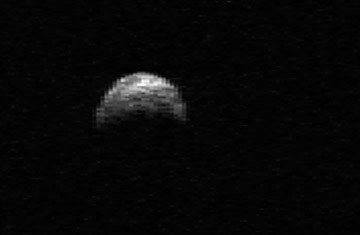
Asteroid 2005 YU55 in a radar image generated from data in April 2010 by the Arecibo Radar Telescope in Puerto Rico
Astronomers have known for several years that Nov. 8, 2011, would end one of two ways: either uneventfully or with a massive global cataclysm that would leave a 4-mile (6.5 km) crater somewhere on the planet, unleash 70-ft. (21 m) tsunami waves and potentially claim tens of thousands of victims. The messiness, they knew, would begin at 6:28 p.m. E.T.
That cocktail-hour moment is the precise time at which asteroid 2005 YU55, a 1,312-ft. (400 m) space rock discovered six years ago, will make its closest approach to Earth. The astronomers' calculations (and they are very, very good calculations) are that we have nothing to fear: the asteroid should miss us by 201,700 miles (324,000 km), which sounds like a lot but on a cosmic scale is still a close call — a full 38,000 miles (61,000 km) closer than the moon is to us. That's a little like a car speeding down your street and clipping your property with its right tires — not enough to hurt you, but enough to make you uneasy.
Still, scientists aren't the least bit concerned. "We are extremely confident, 100% confident, that this is not a threat," said Don Yeomans, manager of NASA's Near Earth Object Observations program, which makes it its business to know these things. "We know the orbit of this object very well."
Indeed, Yeomans goes so far as to call the asteroid's unwelcome drive-by "an extraordinary opportunity" to learn more about the composition of asteroids. Left unsaid is the opportunity it also offers us to sharpen our tracking and early-warning skills against the day when another asteroid takes better aim and clobbers us head-on — which, like it or not, will happen sooner or later.
Asteroids are dangerous cosmic ordnance for two reasons. First of all, there are so many of them. Scientists at the Near Earth Observations program (which also goes by the simpler and more descriptive name Spaceguard) are currently keeping their eyes on 19,500 rocks in the 100-m-to-1-km (330 to 3,300 ft.) range. Those are hardly the only asteroids of that size out there, but they're the ones that also qualify as near Earth — which means they cross or approach our orbit around the sun.
With its massive 7,900-mile (12,750 km) diameter, Earth shouldn't be bothered by a mosquito bite from a 1-km rock, but moving objects pack a bigger punch than their size suggests, and incoming space debris is moving fast indeed — anywhere from 22,000 to 157,000 m.p.h. (35,000 to 253,000 km/h). An asteroid of unknown size exploded over Russia's Tunguska River in 1908, unleashing 30 megatons of energy — 1,000 times more than the Hiroshima bomb — flattening 80 million trees and devastating 830 sq. mi. (2,150 sq km) of landscape. The asteroid that struck Earth 65 million years ago was only 6 miles (9.6 km) across, but it left a 110-mile (177 km) crater and, not incidentally, changed global climate and wiped out the dinosaurs.
So be very afraid, right? Well, sort of. Spaceguard was established in 1998 with an eye toward providing NASA and other space agencies enough lead time to send up intercept missions that would destroy or deflect dangerous asteroids before they reach us. The technology to do that has admittedly not yet been perfected — and there's always a risk that blowing up a big asteroid could simply create many smaller boulders that would hit us like a cluster bomb. But recent unmanned missions that have rendezvoused with asteroids — most notably NASA's Dawn spacecraft — have proved that we at least have the navigational chops to sidle up close to a speeding space rock and even land on it.
The good news is that we should have plenty of time to sharpen our search-and-destroy skills. YU55's trajectory reveals that the last time it troubled us was 200 years ago and that it will not be back around for another 200. Indeed, nothing so big should come our way again until 2028; a slightly smaller, 835-ft. (255 m) asteroid will also buzz us in 2029. But both of those are expected to miss us as well. In general, the human species can anticipate a strike by a YU55-size object only once every 100,000 years.
Meantime, the scientific opportunity Yeomans talks about is a very real thing. Amateur astronomers with big enough telescopes should be able to see YU55 as it makes its closest approach, and professional astronomers will be studying it in much more detail, looking for the chemical signatures of carbon and water. Since asteroids are artifacts of the earliest days of the solar system, the presence of organic molecules riding aboard them might tell us something about how life got started on Earth — and perhaps elsewhere. "A small army of astronomers are pretty excited about it," Yeomans says.
They may have cause to get more excited still. NASA has not yet chosen its next objectives for human space travel, but they include deep-space targets such as the moon, Mars and various asteroids. YU55 has been short-listed as one place worth visiting — which means that we may be calling on the rogue boulder long before it comes back to call on us. Let's see how it likes the rudeness of an unannounced visit.
